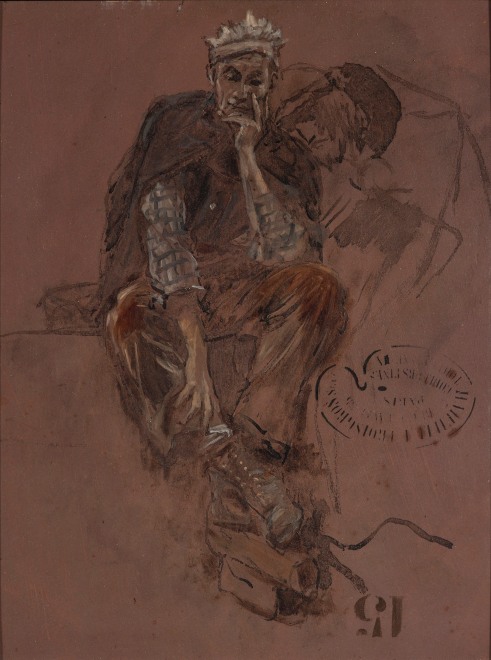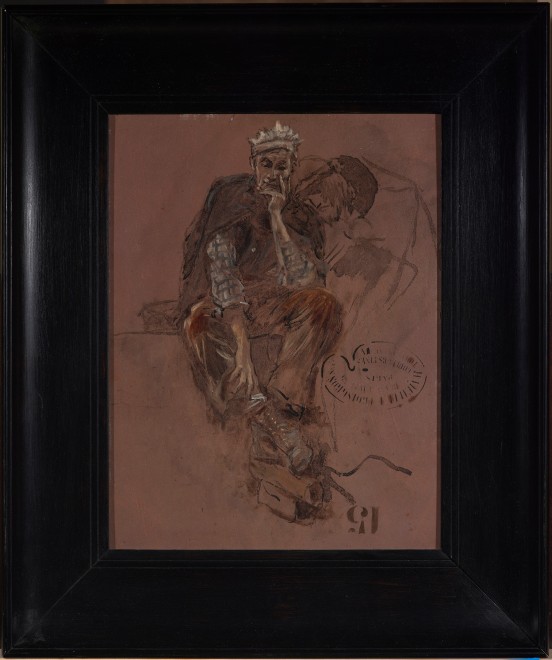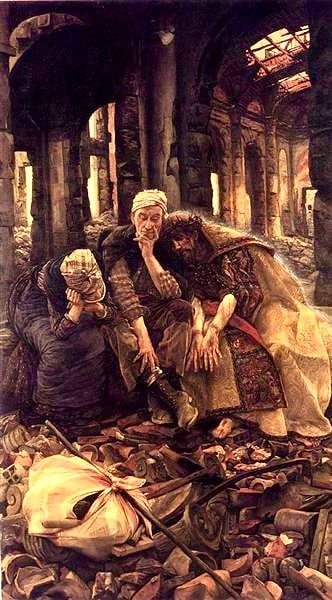Our painting is a preliminary study for the figures of Jesus Christ and the seated man in the final painting.
Two poor wretches have taken refuge in a ruined building. “O God!” they moan amid their complaining. Thus, unwittingly they call upon Him. -a thrill creeps over them-a Being is near.
Provenance
Docteur Marcel Latier
Sale: Me. Biraben, Bergerac, France, 2 December 2007, lot 135
Edouard Ambroselli gallery, 2018
Private collection, France (acquired from the above)
Catalogue note
When James Tissot returned to Paris in 1882, he set out to do a series of paintings depicting distinct types of Parisian women. Known as La Femme à Paris, his intent was to chronicle – on a large-scale – what he saw as different types of la Parisienne, ranging from social climbers to ambitious shop girls. While finalizing a composition for one of the paintings, Tissot went to the Church of Saint-Sulpice, where he inexplicably was drawn to the Mass that was taking place. Legend has it that when the priest raised the Eucharistic host, Tissot experienced a powerful vision where he saw a bloodied Christ comforting the poor.
Tissot’s mystical vision immediately prompted him to work on a monumental painting titled Inner Voices (The Ruins), (The Hermitage, St. Petersburg, fig. 1). Nearly ten years later, when Tissot finally exhibited the painting at the 1894 Salon du Champ-de-Mars, its meaning was clarified in the exhibition pamphlet:
Two poor wretches have taken refuge in a ruined building. “O God!” they moan amid their complaining. Thus, unwittingly they call upon Him. -a thrill creeps over them-a Being is near. He shews [sic] them His blood-stained hands. -They intuitively know the Christ. They are made to understand the meaning of atonement through suffering-that ransom of the soul-of redemption by sacrifice. The glorious mantle which covers Him symbolizes the Hierarchy of the Church. The embroidery upon the golden cope represents the first sin of Adam and Eve, the origin of man’s fall; then the Passion-the kiss of Judas signifying the moral sufferings, and the pierced hands, the physical sufferings.
A cheering warmth emanates from this divine contact, and they are comforted and take courage as they listen to the “Inward Voices.” (as quoted in Judith F. Dolkart, James Tissot: The Life of Christ, The Brooklyn Museum, 2009, p. 11).
Our painting is a preliminary study for the figures of Jesus Christ and the seated man in the final painting. Tissot’s choice of a monochromatic palette is carried over in the finished painting, as is the pose of the man. However, Tissot has only started to develop the interaction between the Lord and his devoted follower; we are only provided a glimpse of Jesus’s head, crowned with thorns, resting on the man’s shoulder and the outlines of what would become His “glorious mantle.”
Inner Voices marked the beginning of the final chapter of Tissot’s career. For the next ten years he would devote himself to the completion of The Life of Our Lord Jesus Christ, a compilation of 350 watercolors illustrating scenes from the New Testament from Jesus’ birth to the Resurrection.






